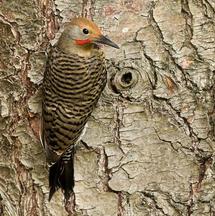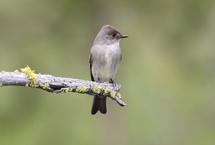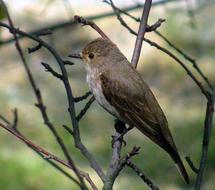saveourplanetearth.com
Call us: (775) 831-1331
Northern Flicker, Olive-Sided Flycatcher, Western Wood-Pewee
“Quick-THREE-beer!” This is a common phonetic representation of the song of the olive-sided flycatcher. When you hear his distinctive song, begin looking for him perched at the very top of a tree. Between songs, he’ll make fluttering forays for bugs, returning to the same perch. He is a large flycatcher, 7-8 inches, mostly gray with a white patch on his breast. He also makes a pit-pit-pit sound, and repeats it at short intervals.
The numbers of this bird are declining, probably due to destruction of its winter habitat. We can help by seeking out shade-grown coffee, which encourages growers to keep the trees which provide the shade. Find out more about this at nationalzoo.si.edu/scbi/migratorybirds/coffee/.
This bird has the longest migration of all the flycatchers, arriving here late in the spring. He winters in Northern South America and I’m pretty sure he has packed up and moved away from Tahoe for the season as I haven’t seen “my bird” in about a month. But he’ll be back and you’ll be ready because now you know what he sounds like.
A flycatcher that looks similar to the olive-sided is the Western wood-pewee. Both birds are grayish-olive with white markings. The wood-pewee has white wing bars versus the white breast patch of the olive-sided, he’s smaller and has a different song.
The pewee I saw and heard for the first time this season. I identified him through his song by listening to my bird tapes, because even though I saw him and heard him, I never saw him singing. The song happened to play as I half listened while I worked and I finally knew who was singing that song! At the same time I realized that the small flycatcher I had been seeing was not a baby olive-sided at all but a completely different bird, the Western wood-pewee.
I’m not very good at this, you see. Now you’re thinking, “….and YOU are trying to teach ME about birds!?” Yes, it’s true but we are learning together, that’s what makes it so fun. I utilize many books, websites and tapes in my effort to learn and I’ll share with you some of these, without which I would still be scratching my head, thinking, “What IS that cute little bird with the delightful song?!”
I use on a regular basis allaboutbirds.org, sponsored by The Cornell Lab of Ornithology. Here you can see pictures of the birds, hear the various songs and calls, watch video, see a range map, or purchase the Cornell Guide to Bird Sounds.
Other on-line resources for learning about birds: whatbird.com for identifying by sight and sound, where you’ll also find “Interesting Facts” and other pieces of information and natureshare.com where you can share your own sightings with others and upload your own photos. Serious birders will want to own tapes of bird calls. I listen to “Peterson Field Guides: Birding by Ear” and “Know Your Bird Sounds” by Lang Elliott.
A common bird you’ve probably seen but most definitely have heard is the Northern flicker, also known as the red-shafted flicker. The flicker is a medium-sized woodpecker, overall brown with black spots, crescents and bars sprinkled throughout his plumage. As is typical of birds, the female is less colorful and the male has a noticeable red mustache. In flight, a white spot on the rump is highly visible, also red on the underside of the wings.
Flickers primarily eat insects and are the only woodpecker that frequently feeds on the ground. They nest primarily in cavities in trees. Both sexes excavate the nest cavity which can take up to two weeks. The female lays 6-8 eggs, which are incubated by both parents for 11-12 days.
Listen for the characteristic drumming of the woodpecker, followed by a sustained “laugh”: ka-ka-ka-ka, which typically lasts for several seconds. He’ll pause for a few seconds then give another call. This song you’ll hear mostly in the spring, when he’s establishing a territory and enticing a mate. Flickers have a call note, sounding like “kyeer”, used for keeping track of each other when foraging.
Northern Flicker
Olive-Sided Flycatcher
Western Wood-Pewee





